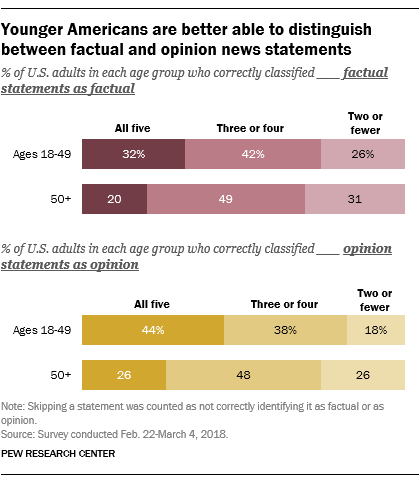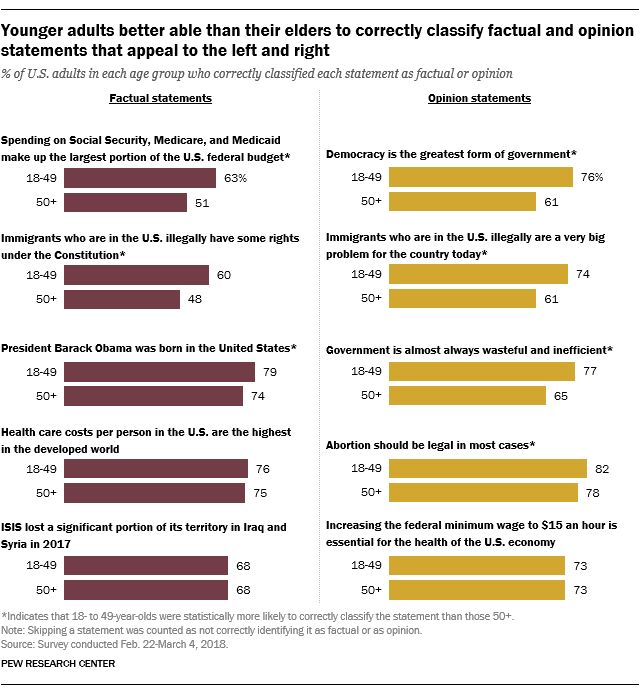While some say wisdom comes with age, younger Americans are better than their elders at separating factual from opinion statements in the news, according to a new analysis from Pew Research Center.

In a survey conducted Feb. 22 to March 4, 2018, the Center asked U.S. adults to categorize five factual statements and five opinion statements. As a previous report revealed, about a quarter of Americans overall could accurately classify all five factual statements (26%) and about a third could classify all five opinion statements (35%).
But age matters, according to this new analysis, as younger adults were more likely than older Americans to correctly categorize all five of the factual statements, and also more likely to do so for the five opinion statements.
About a third of 18- to 49-year-olds (32%) correctly identified all five of the factual statements as factual, compared with two-in-ten among those ages 50 and older. A similar pattern emerges for the opinion statements. Among 18- to 49-year-olds, 44% correctly identified all five opinion statements as opinions, compared with 26% among those ages 50 and older.
When looking at the 10 statements individually, younger adults were not only better overall at correctly identifying factual and opinion news statements – they could do so regardless of the ideological appeal of the statements. (In selecting statements, the study strived to include an equal number that would appeal to the sensitivities of each side of the aisle; to learn how the Center determined the ideological appeal of the statements, see the methodology.)

For example, 63% of 18- to 49-year-olds correctly identified the following factual statement, one which was deemed to appeal more to the right: “Spending on Social Security, Medicare, and Medicaid make up the largest portion of the U.S. federal budget.” About half of those ages 50 and older (51%) correctly classified the same statement. Additionally, 18- to 49-year-olds were 12 percentage points more likely than those at least 50 years of age (60% vs. 48%, respectively) to correctly categorize the following factual statement, which was deemed to be more appealing to the ideological left: “Immigrants who are in the U.S. illegally have some rights under the Constitution.”
Among the opinion statements, roughly three-quarters of 18- to 49-year-olds (77%) correctly identified the following opinion statement, one that appeals more to the ideological right – “Government is almost always wasteful and inefficient” – compared with about two-thirds of older Americans (65%). And younger Americans were slightly more likely than older adults (82% vs. 78%, respectively) to correctly categorize this opinion statement, one appealing more to the left: “Abortion should be legal in most cases.”
This stronger ability to classify statements regardless of their ideological appeal may well be tied to the fact that younger adults – especially Millennials – are less likely to strongly identify with either political party. Younger Americans also are more “digitally savvy” than their elders, a characteristic that is also tied to greater success at classifying news statements. But even when accounting for levels of digital savviness and party affiliation, the differences by age persist: Younger adults are still better than their elders at deciphering factual from opinion news statements.
Beyond digital savviness, the original study found that two other factors have a strong relationship with being able to correctly classify factual and opinion statements: having higher political awareness and more trust in the information from the national news media. Despite the fact that younger adults tend to be less politically aware and trusting of the news media than their elders, they still performed better at this task.
When age is further broken down into four groups, the two youngest age groups – 18- to 29-year-olds and 30- to 49-year-olds – are almost matched in their ability to correctly categorize all five factual and all five opinion statements, and both outpaced those in the two older age groups – 50- to 64-year-olds and those ages 65 and older.
If you would like to test your own ability to categorize the 10 factual and opinion statements, take our quiz.
